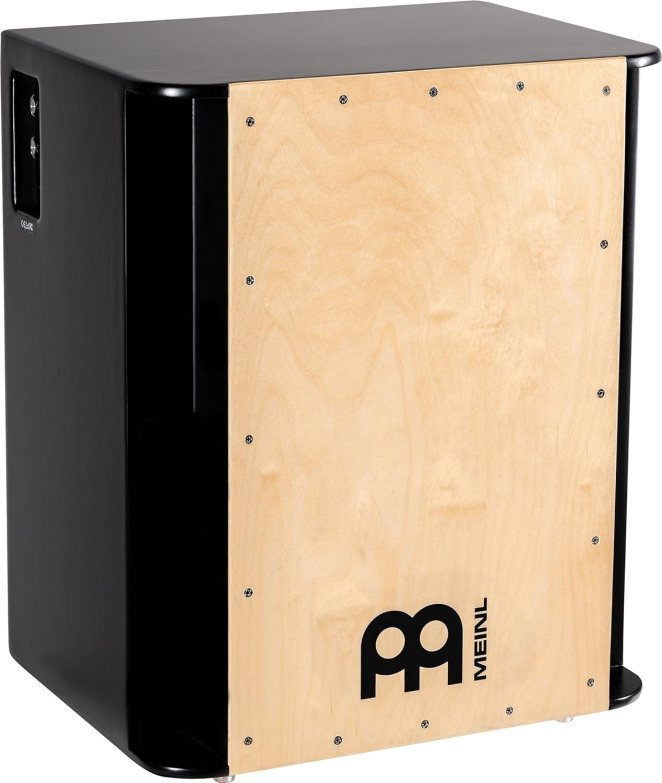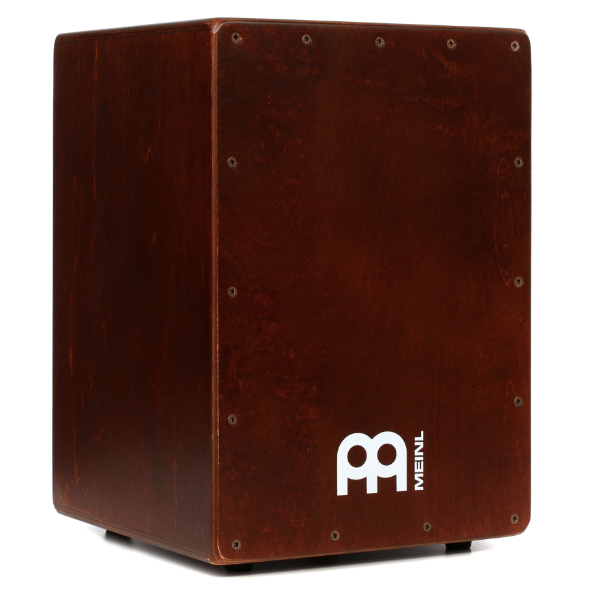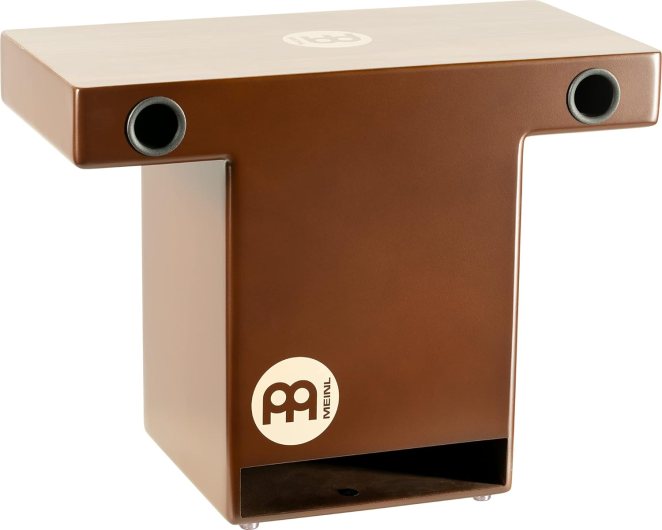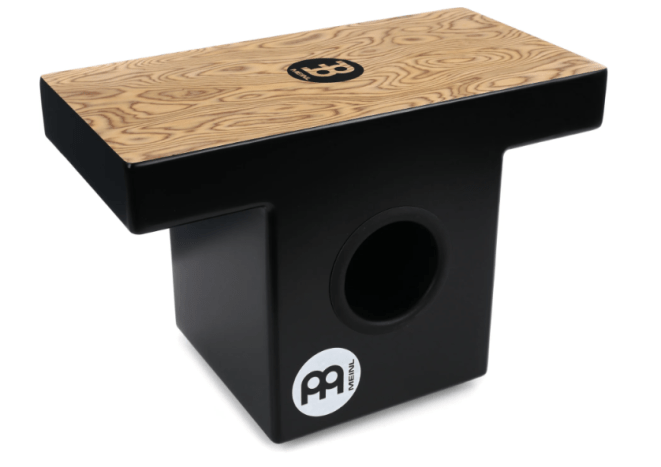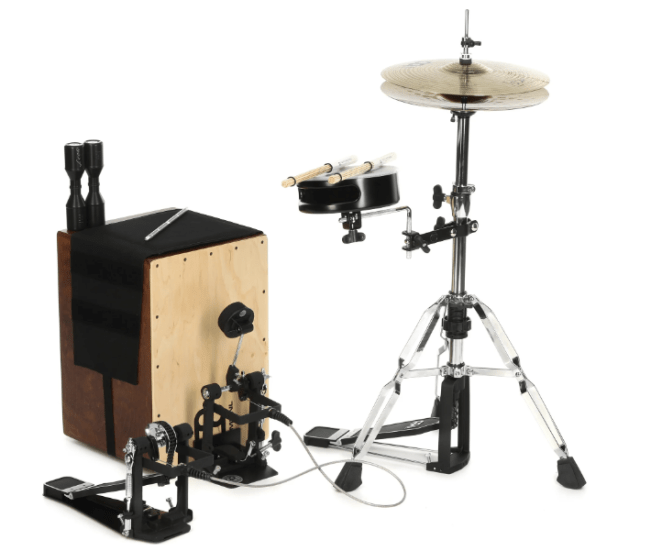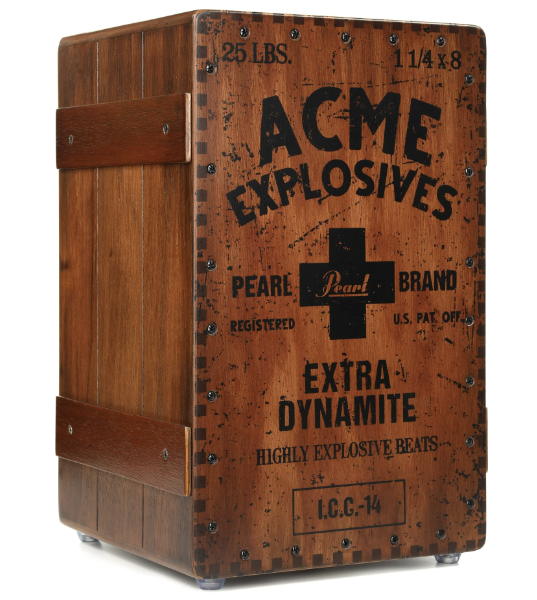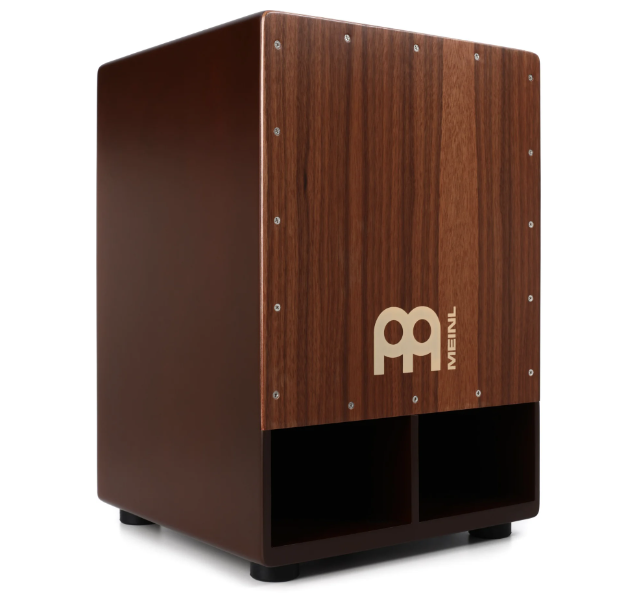Cajon drums are a perfect way to bring rhythm and music into so many situations. I recommend them to anyone who loves music because their convenience is unmatched.
For acoustic guitarists wishing they could jam with a drummer, a cajon is like the key to the city. Now a percussionist can hop in, and suddenly the cajon playing has transformed the whole song.
There are actually a few different types of cajons that all come with their own unique playing styles. I've put together a comprehensive list that includes all the different styles of cajons.
The cajon I'd recommend most overall is the Meinl Percussion Pickup Vertical Subwoofer Cajon. With a huge front plate and deep bass tone, it's a really convenient way to make your rhythm come alive.
But this is a great list to read all the entries of, because each one is truly different from the last. You can do a lot more with a box drum than people think!
After the list, we'll wrap up with a buyers guide, FAQ section, and finally, the last reason why I think the Meinl Cajon is so outstanding.
Quick Summary of the Best Cajon Drums of 2024
- Meinl Percussion Pickup Vertical Subwoofer Cajon (Best Cajon Drum Overall)
- Meinl Percussion JC50BR Compact Jam Cajon (Best Budget Cajon)
- Meinl Percussion Turbo Slaptop Cajon - Walnut (Most Versatile)
- Meinl Percussion Slaptop Cajon (Best Mid-Budget Cajon)
- Meinl Percussion Cajon Drum Set with Cymbals and Hardware (Best Alternative to a Drum Set)
- Pearl Primero Crate-style Cajon - Acme (Most Stylish)
- Meinl Percussion Jumbo Bass Subwoofer Cajon - Walnut Frontplate (Best Bass Tone)
Best Cajon Drums
Best Overall Choice
SPECS
- Baltic birch face plate
- Piezo pickup system
- Dual internal snare wires
This is everything you want in a cajon and more. Although there are tons of variations on this traditional cajon design, I ultimately had to give the top spot to a classic.
This cajon is drum box style, and it's almost 20 inches tall. It's also particularly wide for this style of cajon, giving you distinctly different tones for different parts of the drum.
The bass tone really shines here; it benefits handsomely from the cajon's larger chamber and increased resonance. By palm striking the bottom center of the drum, you can get a kick sound.
The internal electronics take this cajon to the next level. There are some cases where acoustic-electric guitars and such are barely better than a purely acoustic guitar, because the electronics just aren't very good.
But this is NOT one of those times. I was and still am so impressed with this cajon's electronics. You can route it to an amp and adjust the tone and volume.
You even have the option to link another instrument like an electric guitar or bass, so that both instruments only have to route to one amp. This can help add cohesion to your band's sound and decrease setup time substantially.
Best Budget Cajon
SPECS
- Baltic birch, brown finish
- 15in x 10.5in x 10.5in
- Dual internal snare wires
Another thing that makes cajons so widely appealing is you can find some really budget-friendly ones out there. They provide a great low-investment way for just about anyone to hop in on an acoustic jam.
Meinl makes a great compact cajon - the JC50BR - for only around $80. It's 15 inches tall with a baltic birch playing surface.
Its compact size and rustic feel make it a welcome addition to any house, apartment, or studio. Traveling musicians will love it too, as it's one of the smallest and lightest cajons on the market.
Meinl didn't skimp on the design, though. It has nice rounded corners and rubber pads on the bottom for more stability. The internal fixed snare wires give a great snappy high-end snare sound as well.
This cajon makes a fantastic gift for any musician. Even those who don't usually play percussion will be able to hop on the cajon and improve their sense of internal rhythm. It's great for practicing, jamming, or giving an acoustic performance.
Most Versatile
SPECS
- 18.5" x 9.5" x 14.25"
- Passive pickups with bass tone knob and snare tone knob
- Baltic birch body with black finish
- Walnut playing surface
This is one of those innovative instruments that will turn some heads just by virtue of being so rare and unique.
This cajon sits in your lap and allows you to play directly onto the surface like you would with bongos or other similar hand drums.
The glossy walnut playing surface sounds great on its own, and it is even divided into three different zones that produce their own distinctly different tones. There's a bass tone in the middle, and two different snare tones on either side.
But depending on how diverse your playing style is, you can actually get a whole lot more than three different tones from this instrument. The surface is very responsive to how forcefully you play, and what parts of your hand you use.
This cajon even has internal adjustable snare wires, so you can fine-tune the snare sounds to compliment your exact playing style.
Another thing to love about the Turbo Laptop Cajon is that the sound holes are on the front of the instrument, facing toward the audience. This projects your drum parts toward the audience for maximum volume and tonal clarity.
And if that weren't enough, you can even amp up and project this cajon through an amp, just like you can with the number one pick (the Vertical Subwoofer Cajon). Plug in and independently adjust the snare and bass tones using the knobs.
You can link other instruments to it as well, which means if you have only one amp but want to use multiple instruments, it will help solve that problem for you as well.
All in all, this cajon can create an impressive diversity of tones and can accommodate many different playing styles. For such a deceptively simple instrument, it really is amazingly powerful.
Best Mid-Budget Cajon
SPECS
- Birch body, Makah burl playing surface
- 18.5" x 9.5" x 12.25"
- Lap-style slap-top cajon
One thing about cajons that is not typical for musical instruments: $120 is considered mid-budget. How often can you find playable instruments that are this affordable? (Spoiler alert: almost never)
So if you feel like going with a mid-budget cajon, let me suggest the Meinl Percussion Slaptop Cajon. It's a more affordable variant of the previous cajon on the list.
With a black-finished Baltic birch body and a Makah burl playing surface, this lap-style cajon is the perfect way to add a dynamic, lively percussion performance to any acoustic jam.
The left and right side of the playing surface sound reminiscent of an open and closed snare sound respectively, and the very middle of the surface gives a nice clean bass sound.
This lap-style cajon has the edge over a traditional box drum, because of all the different sounds you can effortlessly create.
Give a full percussion performance complete with deep bass tones, a snappy snare sound, and whatever other inventive tones you can come up with. And it's all projected straight to the audience thanks to the cajon's clever forward-facing design.
Best Cajon Kit
SPECS
- 13in HCS hi-hats
- Birchwood snarlers cajon drum with kick pedal
- 7.5in cajon-style snare
That's right, they actually make this: An entire cajon-style drum set, complete with bass, hi-hat, snare, and shaker tones.
This isn't intended to replace a traditional drum set, but it does serve as a whole new take on the instrument.
It comes with bamboo multi-sticks, which are comprised of many thin dowels fastened together. They provide a softer sound than traditional drumsticks. As such, this cajon-style drum set is a great choice for acoustic gigs.
A full drum set will most likely be too loud for an acoustic guitar or acoustic bass to compete with, so this cajon-style set is a great choice if you want something that is almost as versatile as a full drum set, but not so loud that the other instruments will be drowned out.
To play this set, you sit on the wood block cajon and use the kick pedal, which is connected by a wire to the mallet that hits the cajon drum. The cajon has no snare wires, so it's only meant to be used as a kick drum.
The 7.5-inch snare sounds nice and evokes the sounds of reggae, island music, and Latin percussion. The hi-hat sounds great open or closed, especially for something so compact.
I especially appreciate the "cajon blanket," which has pouches for your shaker and sticks. The gig bag is a nice touch as well, as it makes transporting your set so much easier.
When compared to a full drum kit, this thing is an absolute breeze to transport and set up. If your band plays musical styles that work with this type of set, then it's worth it to try one for the convenience alone.
Most Stylish
SPECS
- Meranti faceplate
- 2 internal fixed snare wire sets
- 19.25" x 11.75" x 11.75"
Imagine the audience's surprise when they find out that this box is not just a set piece, but a fully functional percussion instrument that sounds as good as it looks!
The sound hole in the back gives an enhanced bass response, and the internal fixed snare wires provide a snappy snare sound. It's everything you want out of a traditional cajon, and its visual design is brimming with character.
Best Bass Tone
SPECS
- Walnut playing surface
- Forward-facing sound port
- Internal snare wires
Meinl strikes again with another traditional-style cajon that really hits it out of the park. What sets this one apart is that it has sound holes in the front, as you'll be able to see from the product image.
This simple yet effective design choice is what gives this cajon a booming bass tone, and earns it a spot on this list.
With a simple palm strike to the bottom-center of the cajon, you can get a rich bass tone that is projected toward the audience, rather than away from the audience like with most cajons. This can really bring your acoustic performance to the next level.
The top of the cajon also has a rough surface, much like that of a skateboard, to prevent you from slipping and sliding. It's a well-designed cajon in just about every respect, and I highly recommend trying it out if you ever get the chance.
Best Cajon Buyer's Guide
Want a general list of the most important aspects of a cajon? This buyer's guide will tell you exactly what to look out for, whether you buy one of the cajons on this list, or an entirely different one.
Budget
It helps to have a good idea of your budget any time you buy a musical instrument. Fortunately for us starving artists out there, cajons are some of the most affordable instruments on the market.
You can find professional cajon drums for as low as $80 or so. The high-end traditional style cajons can be as much as $300, which is still very cheap compared to most other percussion instruments.
Material
The type of wood or composite that your cajon is made of determines a lot about the instrument. First and foremost, it will have a huge effect on the tone of the cajon. Walnut is my personal favorite wood because it is resonant, durable, and easy on the eyes with its rustic look.
Meinl also has a lot of cajons made of baltic birch, another very high-quality wood that sounds great for percussion.
Extra Features
Finally, consider what uses you have for your cajon, and whether you'd benefit from some of the extra features available in the higher-end models.
The top choice on the list has the very useful feature of being able to amp up for a projected performance. You can even plug in another instrument to increase your band's efficiency and reduce setup time.
These features can be nice, but there's also nothing wrong with an old-school cajon drum box. If it ain't broke, don't fix it!
Frequently Asked Questions (FAQs)
Is cajon harder to play than drums?
On the contrary––most people think the cajon is easier to play than a drum kit. Due to its simplicity, cajon may be the easiest of the percussion instruments to play.
It's a great introduction to percussion instruments, or musical instruments in general, for anyone interested in developing their sense of rhythm.
Do any popular songs have cajons in them?
Cajons have been used in the studio recordings of various songs over the years. Although they're nowhere near as common as conventional drum sets, they still make their way into popular songs every now and then because many people appreciate the unique, organic vibe they create.
Some mainstream bands like The Lumineers, Mumford and Songs, Coldplay, and OneRepublic have all used cajons in their songs.
What styles of music are best suited for a cajon drum box?
Cajons have a lot of personality, and they give a song's percussion a very down-to-earth human feel. They are well suited for world genres like Latin percussion, samba, rumba, and flamenco.
They also just generally work well in acoustic settings because they don't drown out the other instruments. So folk songs and acoustic renditions of just about any genre will sound great with a cajon player in the lineup.
In Conclusion
A cajon's job is to spread good times through music. The music is coming straight from you and your self-expression. No amps, strings, or synthesized tones required.
That's why the Meinl Percussion Pickup Vertical Subwoofer Cajon is such a special instrument. An inspired percussionist can pull off so much with so little when using this instrument. In its simplicity lies so much of its intrigue.
That said, I really can't recommend any of these cajons highly enough. What's great is their fast learning curve. They're an instant door into a jam sesh, for beginners and pros alike. And on top of all this, they're just fun.
